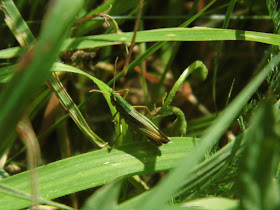16th August 2016
On Tuesday evening I headed out after work, intending to have a quick stroll around Trowse Meadow and the common behind the church, which I haven't visited in years. A combination of work and football parking meant that there was nowhere to pull up along Whitlingham Lane, so I changed plans and instead headed off to the woodland car park.
My first port of call was the woodland watchpoint, although tree growth in front of it means that hardly any of Thorpe Marsh can be seen. I had a look at a decaying tree nearby in case the Coral Tooth fungus was fruiting, but there was no sign of it yet. Out of the woods I visited the lime tree that had attracted so many insects on my last visit, but it was no longer flowering. There were quite a few hoverflies on the Buddleia and knapweed flowers, so I decided to walk along the wildflower meadow to the Great Broad, then to the east end of the Great Broad before retracing my steps.
I saw lots of invertebrates, so this account is just the selected highlights. During a period of sunshine I stopped and heard some grasshoppers calling. Previously I have only recorded Field and Meadow Grasshoppers here, so I was keen to check them both out as Common Green Grasshopper should occur here too. The first grasshopper was green, and looked promising, but I was a bit concerned about the lack of white on the edge of the scutellum markings, and after posting I double-checked and I now think it is a Meadow Grasshopper. The second one was definitely Meadow Grasshopper. Dark Bush Crickets were also calling, but I didn't attempt to find any.
Meadow Grasshopper - greener than the more 'typical' one shown below
Meadow Grasshopper
Along the Great Broad shore I noticed a dark looking wasp. I had seen one a few visits ago and it had eluded me, but this one at least allowed one photo before vanishing. It appears to be a worker Median Wasp, a new species for me. As is so often the case whilst I was inspecting the foliage carefully I found another interesting species, the very colourful Black Willow Bark Aphid (you may need to click on the photo to see the white and orange spots).
Despite checking lots of hoverflies, they all appeared to be species I'd seen before except two. The first one. Epistrophe grossulariae, is new for me provided I've identified it correctly. The second looked initally interesting in the field, but turned out to be Eristalinus sepulchralis, a species that I have recorded here once before.
Scorpion flies are a common sight throughout the country, but not everyone realises that there is more than one species. Only the males can be identified in the field, and then it requires a good view of the genital capsule. I saw one basking and thought it looked a bit daintier than normal, but I managed to get close enough to photograph it and it was Panorpis germanica, the commonest species.
On my way back I stopped to look at a Caddisfly on an Alder. Whilst looking at it I saw a large sawfly larva on the next leaf up. The appearance and host plant suggest that this is the Large Alder Sawfly, Cimbex connatus, that was only re-discovered in Norfolk five or so years ago after a long absence. We currently don't have a Norfolk Sawfly recorder, but I have asked Tony, one of our top dipterists, if he is aware of any other Norwich area records.
Caddisfly sp.
Sawfly larva on Alder
In fact there was another new species too, a solitary wasp called Lestiphorus bicinctus. So there we go, a highly productive hour and a half, particularly as I hadn't intended to go to that area originally.
Lestiphorus bicinctus










No comments:
Post a Comment